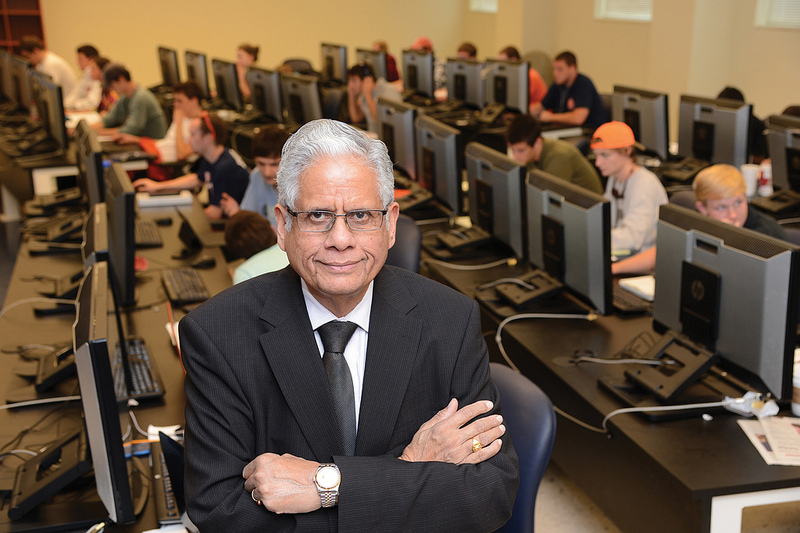 Teaching has more or less remained the same over time: the transfer of knowledge from teacher to student. But it is always in a state of flux as well, particularly as new technologies are able to greatly expand fundamental techniques through the use of multimedia and computer-based instruction, as well as web and online learning, to name just a few of the more obvious. Auburn’s engineering faculty has remained current in these changing teaching tools – two veteran teachers show us how.
Teaching has more or less remained the same over time: the transfer of knowledge from teacher to student. But it is always in a state of flux as well, particularly as new technologies are able to greatly expand fundamental techniques through the use of multimedia and computer-based instruction, as well as web and online learning, to name just a few of the more obvious. Auburn’s engineering faculty has remained current in these changing teaching tools – two veteran teachers show us how.
A dedicated teacher with decades of service, P.K. Raju, Thomas Walter professor in the Department of Mechanical Engineering, has not only seen the classroom move from blackboard to white, but has also been influential in the way that the engineering curriculum has evolved with new concepts, new technology – and new students.
“When I came to Auburn in the mid-eighties, the department head called me in, and gave me a syllabus and a textbook,” Raju remembers. “He pretty much said, ‘well, here you are, now go and teach it.’”
The teaching model, he jokes, was “the sage on the stage.”
So much has changed since then.
“In a sense, what we teach is often the same material – after all, the laws of thermodynamics haven’t changed – but the way in which we teach has changed dramatically, and it has done so as the result of research into teaching methods as well as teaching technology,” Raju explains.
“I was part of a study conducted in 1996 led by William Walker, who was dean at the time, and Larry Benefield, who was then associate dean for academic affairs,” says Raju. “We knew that up to 40 percent of our students dropped out between the freshman and sophomore years. And we knew that these students were academically strong, with good high school GPAs and strong test scores.
“What we found out was that many of our students didn’t really see the relevance between the science, math and physics taught at the freshman level to real-world engineering.”
Auburn’s solution was to introduce classes that brought engineering to the freshman class, including a non-credit survey course that introduces students to all of the engineering curriculums, from aerospace to polymer and fiber and everything in between.
In addition, every department offers a two credit-hour course to introduce students to engineering. The Department of Mechanical Engineering introduces students to case studies and games in the course that it offers.
“The presentation of case studies has been particularly important,” Raju notes. “We have used a wide range of them, including bringing in plant managers to talk to classes. What our students frequently learn is that there are conflicting solutions to real-world problems, and that engineering is often just one component of the whole – there are usually business questions that need to be answered as well, because there are generally dollar issues attached to the engineering problem at hand.”
Raju also points to global education as part of the new learning paradigm.
“We are in such a global economy now, that we absolutely have to bring to our students a sense of what it is like to work in this arena,” Raju observes. “We have sent some 40 students to India during the past six years, partnering with the Indian Institute of Technology. Students collaborate on projects that involve working with international corporations under the program, which is sponsored by the National Science Foundation.”
Raju has also received grants from the National Science Foundation to develop teaching methods that rely on a wide range of technologies, including computer simulation, video and game-playing to teach engineering design.
“We have used these methods in conjunction with case studies, and have now taught more than 10,000 engineering students in partnership with other universities such as MIT and Georgia Tech,” Raju notes. “At Auburn, we have engaged about 100 undergraduates, 40 master’s students and eight doctoral candidates in the development of these novel instructional materials.”
Raju says that generational and cultural differences, as well as differences in individual learning styles. need to be taken into consideration in teaching engineering students.
“We no longer have a generation of students that will simply sit in front of a blackboard in the classroom,” Raju explains, adding, “We may be approaching the end of a generation that will be challenged in the class by watching PowerPoint presentations. Now we have to look at a greater level of computer interaction and game playing.
“Some students learn textually, that is, they literally have to have the words in front of them to understand engineering concepts. Others are very visual in their approach to learning, and have to have some degree of visual stimulation in order to understand the material.”
As a teacher, he says, the bottom line is moving from the “sage on the stage” concept to one in which a teacher is more of a facilitator who gives students an opportunity to think and analyze, rather than memorize.
“There is much more research that needs to be conducted on ways to more fully engage our engineering students,” Raju concludes. “I believe that Auburn is playing an important part in it, and will become better recognized as an innovator not only in engineering practice, but also in engineering education.”